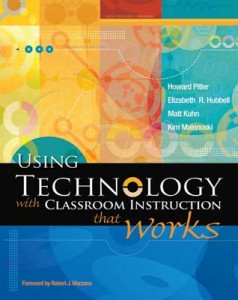 “Using technology for technology’s sake isn’t a good application of instructional time or funding, and it is unlikely to improve student achievement.” (p.217)
“Using technology for technology’s sake isn’t a good application of instructional time or funding, and it is unlikely to improve student achievement.” (p.217)
Over the past few months we’ve taken a look at how technology can support research-proven instructional strategies. Let’s take a few minutes to summarize the ideas presented by Pitler et al in the book, Using Technology with Classroom Instruction that Works.
The quote above, which leads off the Appendix, pretty much sums it up. There are many cool, slick technology tools available, but if the use of technology is not tied to a learning goal, then it’s more than likely not a good use of technology.
We have been working with learning goals and data teams as part of the district initiative on improved learning. This book is a great tie to how technology can support instruction in meaningful ways.
As a quick recap, the planning questions for instruction which should frame any instruction, and links back to the individual posts with the related strategies and technology applications are:
- Overview
- What will students learn?
- Which strategies will provide evidence of student learning?
- Which strategies will help students acquire and integrate learning?
- Which strategies will help students practice, review, and apply learning?
I hope that this book review has helped you to think about ways you can use technology to support your teaching. The array of tools available is great, and gets bigger every day. The challenge is to find the ways in which technology provides meaningful experiences to improve learning.
As always, your thoughts, comments or questions are always welcome!
Image citation:
“Book Cover.†Association for Supervision and Curriculum Development. 5 Nov. 2008 <http://shop.ascd.org/ProductDisplay.cfm?ProductID=107025>.
Comments
One response to “Content Tech: Summary of Using Technology with Classroom Instruction that Works”
[…] Technology with Classroom Instruction that Works – I think people enjoyed the book study here this past year on Point A to Point B because the focus is on improved learning with technology, not just about the technology. I’m […]